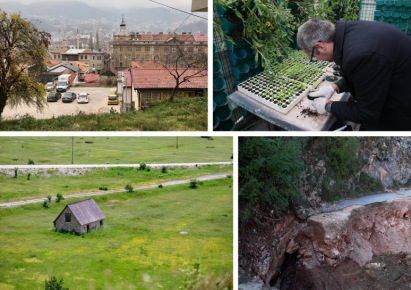Raising Awareness about Air Pollution in One of the Most Polluted Cities in the World
Published: Jul 26, 2019 Reading time: 7 minutes Share: Share an articleAir pollution is an urgent issue in Mongolia, especially in urban areas including the capital Ulaanbaatar, where almost half of the population resides.

An enormous 87% of the overall air pollution in Mongolia comes from the coal that is being used to heat households during the freezing cold winters when temperatures often dip below -40°C, as well as from sturdier buildings with chimneys. Additional air pollution comes from transportation, power plants and water heater plants.
In part due to a series of harsh winters, or dzud, climate change and social issues that have made life harder in rural areas, more and more Mongolians have migrated to the capital in recent years. Consequently, the city’s ger district has greatly expanded. Gers – also known as “yurts” – are portable, circular nomadic homes made out of wood, canvas and felt. Most have a traditional stove for heating, with a chimney leading upwards through the roof.
Gers are now estimated to house over 60% of Ulaanbaatar’s population in settlements around the city. However, due to limited infrastructure, funding and cultural tradition, it has not been feasible to connect all households in the ger areas to a central heating system, offer electric heating solutions or enable everyone to move into apartments.
Air pollution is 50 times greater than the WHO recommended level
Households burn raw coal, the most available fuel, to heat their homes during the winter. Coal combustion produces high amounts of a common pollutant known as PM2.5: tiny airborne particles that measure <2.5 microns in diameter. PM2.5 is considered the most hazardous pollutant to human health, since these particles are so small that, once inhaled, they can travel deep into the human body, potentially causing a range of short- and long-term health effects.
This coal-combustion results and alarming air pollution levels not only present in Ulaanbaatar, but also in other urban areas. At times, the air pollution is 50 times greater than the WHO recommended level. During 2018, IQAir AirVisual recorded Ulaanbaatar as being the 5th most polluted capital city, with an annual average PM2.5 pollution level 6 times the recommended level.
People in Need’s “Right to Breathe” project
Since 2018, People in Need began to address the urgent air quality crisis and launched the Right to Breath (R2B) project the funded by the European Union and the U.S. Embassy in Ulaanbaatar and partnering local NGOs: Mongolian Environmental Civil Council, Mongolian Women Lawyers’ Association and Ger Community Mapping Center. The project aims to strengthen access to information, awareness, situational monitoring and corresponding actions addressing air pollution in Mongolia. It also aims to empower civil society organizations to share information and increase transparency together with the parliament, audit institutions, and the media.
One of the most crucial parts of the awareness raising is to deliver the message that Mongolians can protect themselves from the health risks of air pollution when levels are high. They can greatly reduce their own exposure to air pollution by following simple steps. Below you can see what our public awareness campaign looks like in Mongolia. Take a look at the animations created for public awareness in Mongolia you never know when these tips could come in handy:
Top 10 recommendations to protect yourself against air pollution
1. Continually check air quality information
Our eyes alone are unreliable tools in understanding air pollution. Check reliable air quality information using the free AirVisual air quality app in English and Mongolian, which reports real-time and forecast measurements from both state-run monitors and PIN’s Right to Breathe air quality monitoring network. The app reports air quality levels using color-coded icons, which indicate how serious they are to your health. It also provides recommendations as to how you can protect yourself.
2. Wear anti air pollution masks when outdoors if pollution levels are high
An important step to protecting yourself against air pollution is to wear a PM2.5 filtering mask. Note that many dust and surgical masks don’t protect you from air pollution. When choosing a mask, take care to check that the filter fabric itself has a high PM2.5 filtration rate. For example, ratings such as KN95 and N99 offer high protection (filtering >95% or >99% of PM2.5 respectively). Also, check that the mask seals well against your face, preferably with a nose clip, so that polluted air cannot enter around the sides.
3. Try to stay indoors when air pollution levels are high, especially if you are particularly at risk
Pregnant women, children, elders and people at risk of illnesses are highly vulnerable to air pollution and its impacts. Therefore, these groups are particularly encouraged to stay indoors and limit outdoor activities when the air pollution levels are high. When it is necessary to go outside, they should always wear PM2.5 filtering masks.
4. Use air purifiers with HEPA filters
Indoor air quality is usually affected by the outdoor air quality, since most buildings naturally have gaps in walls and windows through which air can enter. In addition to this, there are many factors that affect indoor air quality including coal burning, smoking, cleaning detergents and low-quality construction materials. We don’t always notice when the indoor air quality of our home or office is worse than outdoors. To clean indoor air, you can either ventilate your space when the air outdoors is clean or, if the outdoor air is not clean, use an air purifier. The purifier should have a HEPA (High Efficiency Particulate Air) filter, which is able to filter out over 99.9% of PM2.5.
5. Reduce air leakage which usually occurs through doors and windows
Pollution can penetrate indoor spaces through cracks or gaps found around windows or door edges. For this reason, it is crucial to fill or insulate the gaps and use window filters in order to prevent outdoor air pollution from entering.
6. Use standardized improved stoves
The difference between ordinary stoves and improved stoves is that the order in which you add the coal. In ordinary stoves, you add the wood first before burning the coal. However, in an improved stove you add the coal first before adding the wood. An improved stove is much better as it allows the coal to burn completely and results in fewer particle emissions. It also keeps things warmer for a longer period of time. Not only can improved stoves help you save 30% of fuel, but they can also reduce the amount of released toxic particles by 20-80%.
7. Use improved fuels
Improved fuel is a mixture of compressed crushed coal pieces and additional flammable chemicals. While still not as efficient as electricity, compared to raw coal, improved coal is more energy efficient and emits less smog, ash and moisture.
8. Use more energy efficient technologies for heating
Most air pollution comes from ordinary household stoves. For this reason, the best solution for heating houses and gers is to use more energy-efficient technologies. By using electric heating, you can reduce air pollution indoors, as well as outdoors.
9. Reduce heat loss by insulating your ger or house
Air pollution will decrease significantly as people insulate their houses in order to reduce heat loss, which in turn reduces the amount of fuel required for indoor heating. Certain areas can get moldy due to the mist that occurs during heat loss, which in turn reduces the quality of the indoor air. By insulating your house or ger with standardized construction materials such as basalt wool and sheep wool, you can decrease your coal consumption for heating by up to 50%.
10. In addition to using air purifiers, grow plants to improve indoor air quality
Coal dust, particulate matter, fungi, and household cleaning products can all be sources of pollutants that are harmful to the environment and human health. In addition to air filters and purifiers, it is also important to grow plants indoors to improve air quality. Leafy green plants can absorb carbon and neutralize different types of air pollutants.
By following the simple steps listed above, everyday individuals can minimize their contribution to air pollution and dramatically improve their personal health. The air quality in Ulaanbaatar, Mongolia is among the worst in the world. Air quality is everyone’s responsibility.



